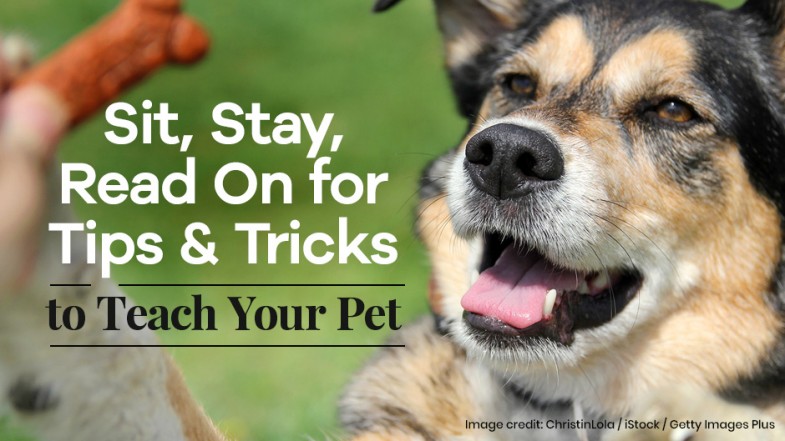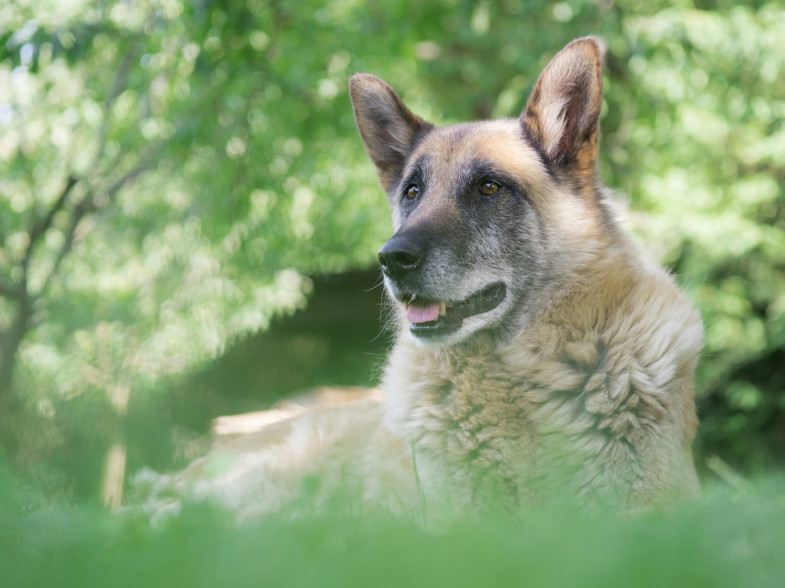Steckelberg Vet Clinic Blog
Sit, Stay, Read On for Tips and Tricks to Teach Your Pet

Are you ready to ring in the New Year with some new tricks to teach your dog or cat? Yes--cats can learn tricks, and they’re rather good at it! January is “Train Your Pet Month”. You can celebrate with your best friend by teaching them a few new moves to impress the neighbors. It’s also a great time to make an appointment with our clinic to work on breaking some bad habits if you’re concerned about new or recurring behaviors that are getting in the way of the bond you share.
Why Train Your Pet?
While performing tricks may seem like fun and games, the training that goes into your pet’s learning has value beyond itself. What are the hidden benefits of training your pet?
- Establishing a reward-based system is foundational for training your dog or cat to come when called, which can keep them safe or help you find them when needed.
- Training can help diminish unwanted or destructive behaviors by redirecting your pet’s energy.
- Training strengthens your bond with your pet through trust and communication.
- The mental stimulation and challenge of training increase your dog or cat’s mental dexterity while staving off signs of aging on the mind.
- Your pet will enjoy more restful sleep after spending some time training.
- Your pet will respond more compliantly when it’s time to visit us for an exam or in case of an emergency.
- Leash training your dog will make walks more enjoyable and reduce strain on her body caused by pulling.
- Your pet will enjoy a boost in self-confidence after learning a new trick as you shower her with praise.
Some Simple Tricks to Train Your Dog
Positive reinforcement training or reward-based training is the best method to encourage your pet’s healthy learning and encourage the desire to train more often. We recommend low-calorie treats when learning a new command since it can often take quite a few to achieve the desired outcome.
If your pet isn’t as food motivated as you wish she could be, try high-value treats like those with fish or peanut butter.
1. “Come”
Recall or teaching your dog to come when you call her helps keep her safe. The last thing you want is your dog to ignore you and continue running head-on into a dangerous situation. If your dog or puppy doesn’t know this trick, it should be a priority for you.
- With your dog on her normal leash (4-foot or 6-foot), let her become distracted or interested in something that she can walk toward.
- Once her attention is focused away from you, call her by saying “Come” and her name while you jog backward. Keep your tone positive and excited. As she’s walking toward you, slow down, and when she reaches you give her a treat.
- Repeat this and after she has it down pat, ask her to come then sit, then give her the treat.
- After you’ve practiced this for a few sessions, you can begin using a longer rope or line. Try a 15 or 20-foot rope.
- Let your dog gain more and more distance as you call her to come and give her a treat. You can even get one of your kids to walk across her line of vision. Remember to only treat her after she’s come all the way to you and sat down.
- Eventually, continue working on this trick but in a fenced-in yard.
Coming when called will be one of the most useful behaviors your dog learns. It can also lose its appeal and your dog’s compliance if your dog always receives a response she perceives as negative. For example, if she knows she’s going to get leashed and brought home from the oh-so-fun park, it becomes much easier to ignore her name being called and keeping playing. So, continue to practice this one with treats from time to time even after she comes without a reward to prevent desensitization to “come” over time.
2. Shake Hands
This one comes in handy when we need to trim your pup’s nails or check her paws for cracks or burrs. It’s also pretty easy.
- Let your pup smell the treat. Then, while your dog is seated, lightly touch or tap your dog’s paw. Be soft and gentle.
- If your dog picks up her paw, put your hand beneath and lift slightly. Immediately say “shake” and give her praise and the treat.
- Repeat, repeat, repeat. Move your hand a little further away and try saying “shake” with your hand outstretched, waiting for hers. When she places her paw on your palm, praise and treat her like the rock star she is.
3. Give Me a Smooch or “Kiss”
This one may seem cutesy, and it is, but it’s super simple. All it takes is a few treats and the desire to receive a sweet smooch from your pooch.
- Start by letting your dog smell the treat. If she already knows how to sit, give her this command followed by the treat.
- After she smells the treat, place the treat on your cheek and when your pup leans in to lap it up, say “kiss” and let her take the treat.
- After a few rounds of this, try pointing to your cheek while saying “kiss,” and if she gives you a lick, give her a treat. And don’t forget to blush.
4. Spin
People find this one quite impressive, and your pup can enjoy a bit of the dizzy-spins. To teach your dog to spin:
- Let her smell the treat and continue to hold it near her nose.
- When she begins to move forward to take the treat, move your hand away from her nose and toward her tail, this will cause her to spin in a tight circle.
- Once she’s made a complete circle, say “spin,” praise and reward her.
Two Simple Tricks to Teach Your Cat
Cats also benefit from learning tricks. And they tend to learn really quickly. When preparing to train your cat, choose a calm, quiet area of your home and place your kitty on the edge of a surface like a sofa or bed, facing you.
If you haven’t trained your kitty, here are two tricks to get you started (spoiler: they’ll sound familiar):
1. Sit, Kitty
- Let your kitty smell her treat. The stinkier the better, usually! Then slowly move the treat above her nose and backward toward her ears and shoulders.
- Your cat should naturally lower her bottom while keeping her nose pointed at the treat.
- As soon as her bottom is down, reward her with the treat.
- After repeating this a few times, begin saying “sit” simultaneously while treating her.
- After a few training sessions of 5-10 minutes, she will begin sitting on command.
2. Shake
After your cat learns “sit,”’ move onto teaching her this classic trick.
- Gently touch your kitty’s paw to encourage her to lift it up. If she doesn’t lift her paw, gently lift it yourself.
- When she does lift her paw, slip your hand underneath and give her a treat.
- After a few repetitions, begin saying “shake” to build the connection with the command.
Have Fun and Train On!
For better success in your training sessions, give your pet breaks every 10-15 minutes, keep training sessions short, and be consistent. You’ll find these commands can help you with some of your pet parent duties and give your pet the challenge she needs to rest well and feel accomplished.
For any questions you may have, whether what type of treats to use, questions about weight gain during training, or appropriate training for your pet’s life stage, don’t hesitate to reach out to us.
Image credit: ChristinLola / iStock / Getty Images Plus
Categories
Recent Posts

The holidays are full of sparkle, laughter, travel, and to-do lists a mile long. As joyful as this season can be, it often means busier schedules and less time for everyday routines. In the middle of the holiday rush, it's easy to overlook one very important family member: your pet.

If you're lucky enough to have a senior pet, you know just how special that bond becomes over time. From cozy afternoons on the couch to the look in their eyes that says, "I've known you forever," there’s a deep and quiet understanding between you. As pets get older, though, their needs change. Aging isn’t a disease, but it does require us to adapt how we care for our beloved companions.

Have you ever walked into a veterinary clinic, had your pet whisked gently away, and wondered who all those smiling, scrub-wearing professionals are? You might recognize your pet's veterinarian, but chances are there’s another key person working hard behind the scenes (and sometimes right beside you).